MONEY FOR EVERYTHING, IMPROVE THE POWER FACTOR OR PAY MORE TO GET LESS!!!
Definition of POWER FACTOR:
All electrical circuit when switched on, and is charged with voltage, there has always been an Electrical angle difference between the applied voltage and current. Cosine of that angle is called POWER FACTOR.
If a purely resistance is fed with a voltage then the voltage and current will be at same phase hence power factor angle is 0 degree so power factor is cos(0)=1
 |
| FIG 1:PURELY RESISTIVE CIRCUIT/ https://electricaltechnologyrishi.blogspot.com |
For a purely inductive circuit the phase angle between voltage and current shall be 90 degree, where the current phasor will lag the voltage by 90 degree, causing power factor to be 0 lagging.
 |
| FIG 2:PURELY INDUCTIVE CIRCUIT/ https://electricaltechnologyrishi.blogspot.com |
For a purely captive circuit the voltage will lag behind the current by 90 degree, hence current leading the voltage by 90 degree, so here also power factor angle is 90 degree and power factor is 0 but leading.
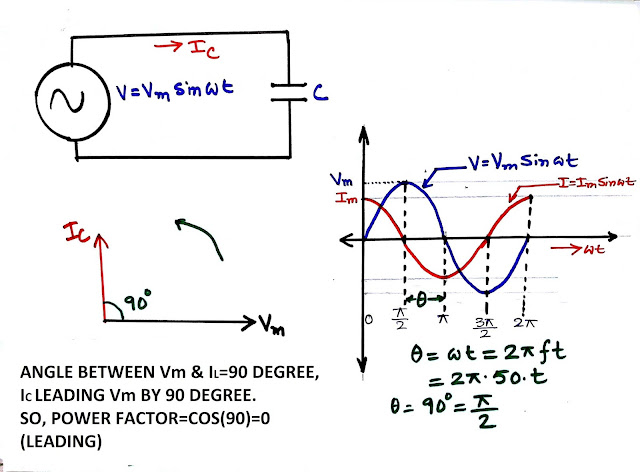 |
| FIG 3:PURELY CAPTIVE CIRCUIT/ https://electricaltechnologyrishi.blogspot.com |
So, whether a power factor is leading or lagging shall be determined by the factor that if the current is leading the voltage or lagging the voltage.
In practice all electrical loads are inductive in nature, but they are not purely inductive rather a combination of resistance and inductor. So their power factors are lagging but not 0.
In general all electrical loads that have core material say motor are designed for a power factor 0.85 to 0.9. In our article we shall presume that all electrical loads are having power factor of 0.85 lagging.
In industry motor is the major loads, and they are the main culprit for low power factor. Apart for motor there may be furnace, heater etc. but being resistive load in nature they do not effect power factor significantly.
In the article TRANSFORMER PHASOR DIAGRAM we showed that transformer also causes lowering of power factor, i.e. if load end power factor of a transformer is 0.8 source power factor will be less than 0.8. So transformer also reduces power factor to some extent. These type of electrical component reduces the power factor.
So it is okay that Cosine of angle between voltage and current is power factor. But what is its significance? Suppose if we say a motor is rated as 85 kW, 0.85 p.f (85 kW is just taken for simplicity of calculation, however 85 kW is not a standard motor rating) what shall it mean.
It means that the active power output is 85 kW, but it shall draw some more power from the supply, we presume the motor has 100% efficiency, so output and input are same.
The motor shall draw 85/0.85=100kVA power between which 80 kW is active power. But this 80 kW and 100 kVA are not linearly related, but they have a vector relation.
We shall have a component of
(100^2-85^2)^0.5=52.68
This is the reactive power.
Now if efficiency is 90% instead then the kW drawn from supply shall be
=85/0.9=94.44kW
KVA from supply=100/0.9=111.11 kVA &
kVAr from supply=52.68/0.9=58.53 kVAr.
Also (94.44^2+58.53^2)^0.5=111.11
So we can see that to deliver a certain amount of active power we need some reactive power. Ratio of active power to apparent power (kW/kVA) is called power factor.
The better designed machine shall have higher power factor hence low requirement of reactive power. But it can never be zero.
Because all Electrical machines supply power by electro magnetism. So a certain amount of power is required for the machine core to get magnetized. This power doesn't give any active output but it is necessary to give active output, hence it is called reactive power.
The core coils forms inductive circuit, hence the magnetizing current is always lagging in nature, causes reactive power demand of a machine.
Both the reactive and active power are drawn from the source. Our aim shall be to improve source power factor, i.e. reducing reactive power demand from the source.
Because low power factor causes penalty to industry, i.e. supply authority charges more money for lower power factor, and for high power factor i.e. 0.99 supply authority gives award to the consumers.
So if we can supply the kVAr demand locally, our system will draw less kVAr from source, so power factor will be improved.
As capacitor draws leading current it injects reactive power to the system. So addition of capacitor in parallel to the load will increase the system power factor. Lets see the below images
From the above images we can understand how capacitor improves power factor.
Now we have to size the capacitor. Means we have to determine the kVAr rating of a capacitor.
Suppose our system is running at a power factor of 0.85, and we want to improve it to 0.99
So from Fig-5 as shown above
ϴ1=Cos-1(0.85) =31.78 degree
ϴ2=Cos-1(0.99)=8.11 degree
KVAr1=kW*Tan(ϴ1)
KVAr2=kW*Tan(ϴ2)
KVAr Cap=KAVr1-KVAr2
=kW*(Tan(ϴ1)-Tan(ϴ2))
Selected capacitor kVAr rating shall be of nearest round figure.
The power system Single line diagram shall be like below.
Power Flow before and after capacitor placement.
So it is okay that Cosine of angle between voltage and current is power factor. But what is its significance? Suppose if we say a motor is rated as 85 kW, 0.85 p.f (85 kW is just taken for simplicity of calculation, however 85 kW is not a standard motor rating) what shall it mean.
It means that the active power output is 85 kW, but it shall draw some more power from the supply, we presume the motor has 100% efficiency, so output and input are same.
The motor shall draw 85/0.85=100kVA power between which 80 kW is active power. But this 80 kW and 100 kVA are not linearly related, but they have a vector relation.
We shall have a component of
(100^2-85^2)^0.5=52.68
This is the reactive power.
Now if efficiency is 90% instead then the kW drawn from supply shall be
=85/0.9=94.44kW
KVA from supply=100/0.9=111.11 kVA &
kVAr from supply=52.68/0.9=58.53 kVAr.
Also (94.44^2+58.53^2)^0.5=111.11
So we can see that to deliver a certain amount of active power we need some reactive power. Ratio of active power to apparent power (kW/kVA) is called power factor.
The better designed machine shall have higher power factor hence low requirement of reactive power. But it can never be zero.
Because all Electrical machines supply power by electro magnetism. So a certain amount of power is required for the machine core to get magnetized. This power doesn't give any active output but it is necessary to give active output, hence it is called reactive power.
The core coils forms inductive circuit, hence the magnetizing current is always lagging in nature, causes reactive power demand of a machine.
Both the reactive and active power are drawn from the source. Our aim shall be to improve source power factor, i.e. reducing reactive power demand from the source.
Because low power factor causes penalty to industry, i.e. supply authority charges more money for lower power factor, and for high power factor i.e. 0.99 supply authority gives award to the consumers.
So if we can supply the kVAr demand locally, our system will draw less kVAr from source, so power factor will be improved.
As capacitor draws leading current it injects reactive power to the system. So addition of capacitor in parallel to the load will increase the system power factor. Lets see the below images
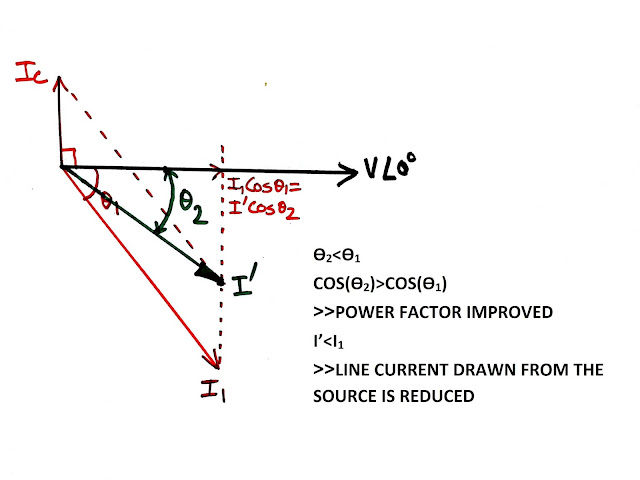 |
| FIG 4:POWER FACTOR IMPROVEMENT BY CAPACITOR/ https://electricaltechnologyrishi.blogspot.com |
From the above images we can understand how capacitor improves power factor.
Now we have to size the capacitor. Means we have to determine the kVAr rating of a capacitor.
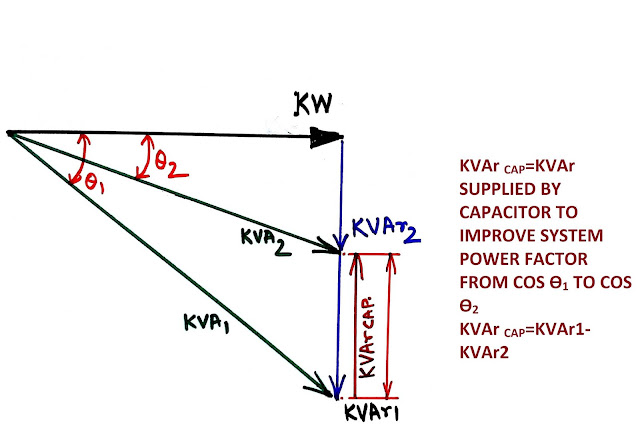 |
| FIG 5:POWER TRIANGLE DIAGRAM FOR POWER FACTOR IMPROVEMENT/ https://electricaltechnologyrishi.blogspot.com |
Suppose our system is running at a power factor of 0.85, and we want to improve it to 0.99
So from Fig-5 as shown above
ϴ1=Cos-1(0.85) =31.78 degree
ϴ2=Cos-1(0.99)=8.11 degree
KVAr1=kW*Tan(ϴ1)
KVAr2=kW*Tan(ϴ2)
KVAr Cap=KAVr1-KVAr2
=kW*(Tan(ϴ1)-Tan(ϴ2))
Selected capacitor kVAr rating shall be of nearest round figure.
The power system Single line diagram shall be like below.
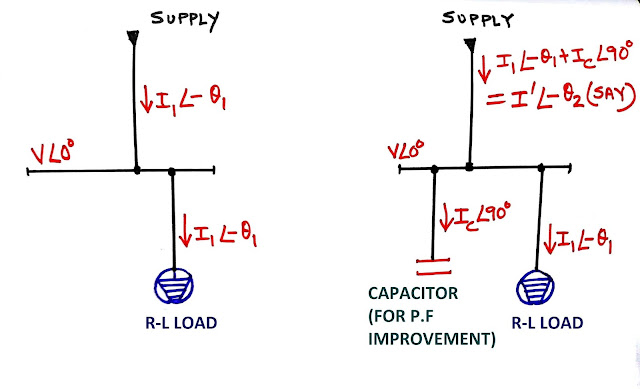 |
| FIG 6:CURRENT FLOW BEFORE AND AFTER CAPACITOR PLACEMENT/ https://electricaltechnologyrishi.blogspot.com |
Power Flow before and after capacitor placement.
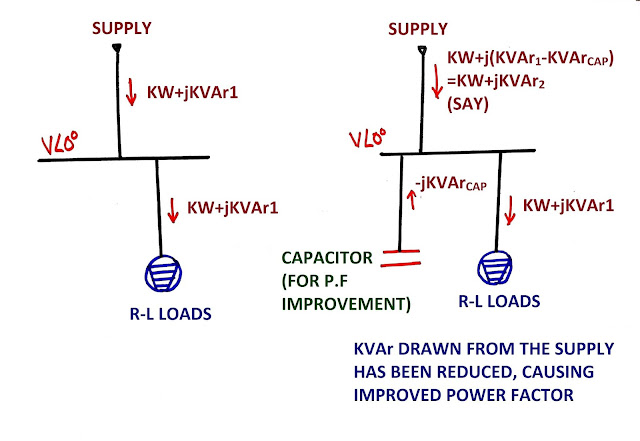 |
| FIG 7:POWER FLOW BEFORE AND AFTER CAPACITOR PLACEMENT/ https://electricaltechnologyrishi.blogspot.com |
So this is the technique by which we can calculate the capacitor kVAr to improve system power factor from a certain value to our desired one.
Hope you have enjoyed this article. Please share your opinion in the comment box. And for all of our other posts please visit the page "Site Map"
Thank you.......





Very nice information.
ReplyDeleteRead More Article
Hello there, this is amazing blog i really appriciated. thats great you are good writer
ReplyDeleteClick here
Click here
Click here
Click here
Click here
Click here
Click here
Click here
Thank you
ReplyDeleteHello there, this is amazing blog i really appriciated. thats great you are good writer
Click here
Click here
Click here
Click here
Click here
Click here
Click here
Click here
Thank you
Very nice in depths information.
ReplyDeleteWe Create And Install Bespoke Fitted Wardrobes, Walk-In Wardrobes, Built-In Wardrobes & Storage Solutions. Unique Design And Fascinating Quality. Based In Nottingham. Storage Solutions
ReplyDeleteNice post about electricity power factor. Eye-catching title. My Windows Version phone takes long to charge. I am using too much electricity?
ReplyDeleteThank you so much as you have been willing to share information with us. We will forever admire all you have done here because you have made my work as easy as ABC. more info
ReplyDeleteIf you're responsible for maintaining an electrical system, then you know that power factor improvement is an important part of keeping things running smoothly. Follow these best practices to make sure your system is up to snuff.
ReplyDeleteI appreciate the effort taken to explain power factor improvements and there are few more electrical product can help in power factor improvement in Industrial
ReplyDelete50 Amp Power Contactor
32 Amp Power Contactor
400A 4 Pole MCCB
40 Amp Power Contactor
25 Amp Power Contactor
Siemens 100 amp MCCB
Thanks for the Article It was Extremely Helpful For me to Understand. Here are Some of the Top Renowned Switches that can Help You Improve Your home.
ReplyDelete6 Amp Switch
16 Amp Switch
16 Amp Socket